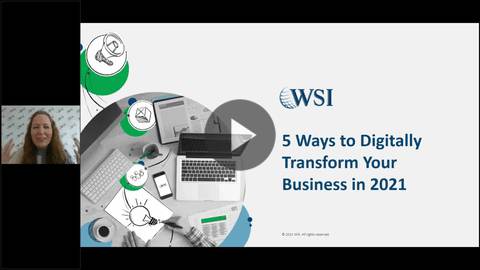As the global leader in digital marketing, WSI is proud to introduce one of our consultants to discuss how you can digitally transform your business in 2021. Kelly Biggs has over 20 years’ experience in sales and marketing, obtained her MBA in 2009, and has won numerous awards including Top Sales Consultant at Fortune 500 and small to medium businesses.
The webinar is available to watch here.
What is Digital Transformation?
Let's start with a definition: “Digital transformation integrates digital technology into all business areas, resulting in fundamental changes in how your business operates and the value you deliver to your customers. Transformation is driven by customers rather than the business itself.”
Should You Digitally Transform Your Business?
This question can require some soul-searching for most business owners. But some early indicators that it's time to digitally transform your business include:
- Decreased (or lack of) referrals.
- Repeat business is falling off.
- Your technology feels old.
Five Ways to Digitally Transform Your Business
End-to-end digital processes keep the customer in mind and should be performed concurrently and continuously.
1. Attract Prospects
Inbound marketing attracts prospects to your website using enticing content. Examples include keyword research, PPC, SEO, content marketing, influencers, social.
Get the most out of inbound marketing by:
- Understanding your target market and building a buyer persona.
- Leveraging keyword research to increase SEO and marketability of content.
- Showing up where your customers are - Instagram for millennials, LinkedIn for B2B.
2. Convert Visitors
Simply said, conversion tools convert visitors into leads. Conversion rate optimization is the intersection of:
- User intent – install software (like Hotjar) to see how users are interfacing on your website.
- Company goals – create content with the user in mind that adds value, connects, and is relatable over sales-y.
- Website experience – movement on your website as it creates distractions rather than conversions.
3. Close Leads
Once you capture your leads in the marketing or sales funnel, you want to turn them into customers. Some marketing and sales automation tools you should keep in mind include:
- Create workflows in advance and automate repeatable processes.
- Pinpoint sales and marketing KPIs to increase ROI.
- Personalize the customer experience.
- Increase sales team efficiency.
Email automation nurtures top-of-funnel leads as they move through to sales-qualified leads.
- Use an intriguing subject line.
- Personalize the content.
- Mention the purpose.
- End with a CTA.
- Focus on the reader.
CRM – customer relationship management – allows sales teams to walk leads through the sales funnel using established processes until the sale is closed (and beyond).
- Establish sales stages.
- Set weekly cadence.
- Review stalled deals.
- Evaluate data without judgement.
4. Delight Customers
Online reputation management (ORM) allows you to control online conversations about your business, because 79% of customers trust online reviews as much as personal recommendations:
- Set up a process to proactively get reviews.
- Respond to all reviews within 24 hours. A bad review is an opportunity to engage.
- Measure your ratings to identify how you can improve.
5. Measure Promoters
Measure your efforts using all the relevant analytics - website analytics, Google ads, social platforms and ads, online visibility - to:
- Monitor performance for emerging trends.
- Understand clients’ acquisition, behavior, conversion.
- Set strategy.
- Identify shifts in the market.
- Measure ROI.
For more information on how you can digitally transform your business, contact WSI today. Or catch up on the entire webinar, 5 Ways to Digially Transform Your Business in 2021, here:






